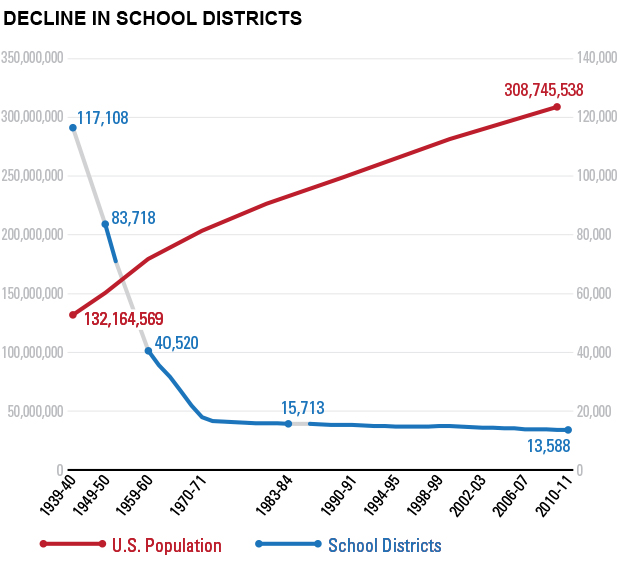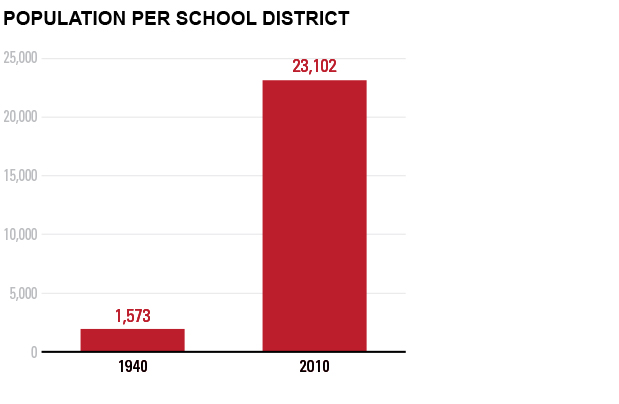The Decline of “Voting with Your Feet” in American Public School Districts
Historically, American public school districts have been governed by locally appointed or elected school boards, and families (mostly) have been free to live in whatever school district they wished. Several decades ago, this system provided a large degree of choice for many families, but over the past 70 years, choice among public school districts has declined dramatically.
As shown in the graph below, there were more than 83,000 school districts in the United States during the 1939-40 school year. By 1961, there were less than half that number—only 40,520 school districts—and in 1983, that number had dropped to 15,747. Although the rate of decline has slowed significantly, by 2010, there had been another decrease of more than 2,000 school districts to 13,588.
Please note that the number of school districts after 1983 is not directly comparable to the number of school districts prior because of differences in data collection. Nevertheless, the overall pattern is stark—American families have dramatically less choice of public school districts today than they had in the 20th century. While populations have grown exponentially, the number of public school choices have decreased even more dramatically.

To put that decrease into context, in 1940, there was one school district for every 1,573 Americans, making school districts small and allowing for more diversity for American families. By 2010, however, there was only one public school district for every 23,102 Americans, giving a local area of 75,000 residents, on average, only three school districts from which to choose.
While the number of school districts declined by more than a factor of six between 1940 and 2010, the amount of choice among school districts declined by more than a factor of 14, when adjusted for the growth in U.S. population.

Before his untimely death, Charles Tiebout, an economist and a contemporary of Milton Friedman’s, made a very interesting and important contribution to our understanding of government-provided goods and services. Tiebout suggested that families could “vote with their feet” and move among local jurisdictions, which would help ensure that locally-provided government goods and services would be produced in a cost-efficient manner that would also conform to the tastes and preferences of local residents. With regards to the latter, different local governments would provide different amounts and types of goods and services, and citizens would sort themselves into different communities based on their different preferences and desires.
Tiebout concluded his famous 1956 paper, “A Pure Theory of Local Expenditures,” with these words: “local government represents a sector where the allocation of public goods (as a reflection of the preferences of the population) need not take a back seat to the private sector.” In his research, he endeavored to find some conditions where government provision of a specific good or service would be better than provision in the private sector. That is, under what conditions would a product be produced by government in a manner where there was more competition and choice for consumers, relative to the private sector?
If there was only one firm—a monopoly—in the private sector (or, if there was a near-monopoly in the private sector), then Tiebout theorized that government provision of the product would be better for consumers in terms of lower prices, higher quality, more innovation, and more product diversity—under certain conditions. Two of the most important of those conditions were that the product was produced by local governments (not the state or the federal governments) and that customers (citizens) could move among local jurisdictions at almost no cost. This “voting with your feet” would be akin to families choosing where to go on vacation based on price, what they like to do to relax, and the quality of amenities.
How has that “voting with your feet” worked in public education so far?
As America’s public schools become more centralized, American families have been given less and less opportunity over time to hold public schools accountable by “voting with their feet”—less opportunity to find a public school district that matches the needs of their child, and less opportunity to find a public school district that provides a given quality of education at the lowest possible taxpayer cost.
To read the second installment of this three-part series, see Dr. Scafidi’s next post where he discusses why public schools have become more centralized.




